
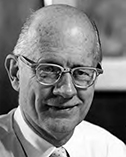 Frederick Seitz
Frederick Seitz
1962-1969 NAS President
The new president was Frederick Seitz (1911–2008), who had served on the Academy's Council previously and held the office between 1962 and 1969. He quickly realized that Bronk's initiatives had generated a large and continuing increase in the advisory activities of both the Academy and the National Research Council. It would no longer be possible to manage them on a part-time basis. On reviewing this matter, the Council of the Academy decided that henceforth the president's position would be full time, and for a maximum of two six-year terms. Bronk had resolved the problem of dealing with the in-creased responsibilities that go with growth in his own way, first by accept-ing the position of president of Johns Hopkins University in nearby Baltimore, an easy commute to and from Washington, and then by shifting to a less conventionally demanding post in New York.
The 1960s began to yield many of the fruits of the scientific endeavor that had begun during and after World War II following the discovery at The Rockefeller University in 1944 by Avery, McCarty and MacLeod that strands of DNA carry the genetic message, and the subsequent development by Watson and Crick of the entwined pair model for the genetic units that reside in the cell and ultimately determine the characteristics of the living organism. By the 1960s, many of the details of the precise operation of the genetic system, including the genetic code, were being revealed. Biology at the molecular level was now a very open field for research with promises for the development of entirely new areas of clinical medicine.
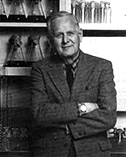 Professor Maclyn McCarty, M.D. (pictured right), the pioneering biochemist of the Avery team at The Rockefeller University (and much more). In 1983, he used the facilities of the Commonwealth Book Program to present a detailed account of the course of the discovery: The Transforming Principle (W. W. Norton).
Professor Maclyn McCarty, M.D. (pictured right), the pioneering biochemist of the Avery team at The Rockefeller University (and much more). In 1983, he used the facilities of the Commonwealth Book Program to present a detailed account of the course of the discovery: The Transforming Principle (W. W. Norton).
Similarly, the studies of the composition of the atomic nucleus with accelerators of ever-higher energy revealed the existence of a plethora of new particles. A great deal of effort has gone into the process of establishing their interrelation with much initial success. In parallel with this were reviews of studies regarding the manner in which the heavier chemical elements are created from light ones by accretion in highly radioactive stars.
It had long been known that there were links between fossils in western Africa and eastern South America. In 1912, the Austrian geophysicist Alfred Wegener proposed that the continents are able to drift on a semi-plastic base and may occasionally be joined for periods of time. Most leading geologists did not accept Wegener's theory but, starting in the 1930s, Hess (1906–1969) of Princeton University decided that the concept deserved serious testing and began measuring the ages of the basaltic rocks that form continuous platforms or “plates” on the ocean floor. His speculations at this early time were augmented by those of a remarkably prescient English geologist, Arthur Holmes.
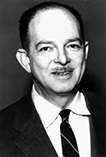 Harry Hess: Roger Revelle
Harry Hess: Roger Revelle
Hess (pictured left) joined the naval reserve and began carrying out measurements from naval vessels at every opportunity before, during and after World War II. His very active wartime service began the day after the bombing of Pearl Harbor. The first assignment placed him as one of the leaders of a group involved in the successful search for German submarines off the Atlantic Coast. He then became commander of an attack transport in the Pacific Ocean for an extended period. This activity provided much opportunity for oceanic research in between active military engagements. He discovered that none of the rocks in the basaltic base of the ocean floor were older than one hundred million years, in support of the view that the floor is subject to a mechanism that produces flow and replacement of older material by subduction under continents or by the production of new land. The mechanism at work is presumably adequate to move continents and build mountains.
In 1960, Hess prepared a report proposing that volcanic activity along midocean ridges plays a key role. The determination of the exact nature of the process involved presented a major geological puzzle that was finally resolved by studies carried out by F. J. Vine and D. H. Mathews, two English geophysicists, and by Tuzo Wilson, a Canadian. The first pair studied the orientation of the magnetic traces found on rocks that flow out on either side of the ridges. Such traces alternate their magnetic signature with reversal of the earth's magnetic field. The experiments showed that the traces are symmetrically disposed on either side of the fissures where the upwelling of magma occurs. The basic model for the system was completed by Wilson, who proposed that the forces responsible for ocean floor motion arise from convective currents beneath the ocean floor that exert tangential forces upon a system of relatively rigid basaltic plates that are generated by solidified magma more or less continuously exuded from volcanically active ocean ridges. The research involved in these revelations was just coming to fruition during the Academy's centennial celebrations and caused much excitement among those interested in the topic. Unfortunately, Hess who had zealously persisted in pursuing the matter from its unpopular beginnings died prematurely soon after. He was raised to the rank of rear admiral in the reserve as a result of his wartime service.
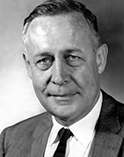 Hess had been asked to prepare an address on this rapidly unfolding topic at the centennial meeting of the Academy, but was much too involved in research at the moment to do so. His admiring friend Roger Revelle (pictured right), an oceanographer of comparable stature, prepared Hess' contribution to the occasion, all under Hess' name.
Hess had been asked to prepare an address on this rapidly unfolding topic at the centennial meeting of the Academy, but was much too involved in research at the moment to do so. His admiring friend Roger Revelle (pictured right), an oceanographer of comparable stature, prepared Hess' contribution to the occasion, all under Hess' name.
It may be added that in summarizing Roger Revelle's status as a scientist and human being in his Memoir, three of his professional colleagues stated:“Roger Revelle was one of the twentieth century's most eminent scientists. His life's work personified Ernest Boyer's four categories of scholarship: discovery, integration, dissemination and application of knowledge. He brought his talents in these categories to bear on the study of the planet we inhabit and our interaction with that planet. His interests and intellectual reach spanned the physical, biological and social sciences, engineering and humanities. He enhanced the status of oceanography in world science, pioneered in the study of global warming and brought a fresh approach to issues of population, world poverty and hunger. Revelle was an inspiring leader of scientific enterprises and an insightful and sagacious educator. He was the intellectual architect for the creation of a great university. He excelled in the communication of science and its implication to policy makers and to the public. Revelle was an exemplary citizen in his community, his country and to the world.”
Apart from issues such as those mentioned, which carry a strong message of enlightenment as well as a significant promise of being useful, there were many areas of scientific research that came to fruition in the 1960s in which useful applications turned out to be by far the most important byproduct. One thinks for example of the emergence of new synthetic polymers that have become an indispensable adjunct to industry and to modern living. Or the special roles that semiconductors, which were once regarded as chemical and physical curiosities, now play in our everyday lives. It was incidentally during this decade that several industrial research laboratories were struggling, ultimately with much success, to draw out the revolutionary promises inherent in the newly invented technology of integrated circuits. A key problem was to reduce production costs to the range required for everyday commercialization, in which event the influence of such circuits would presumably become “all pervasive” as Patrick Haggerty predicted and as ultimately proved to be the case.
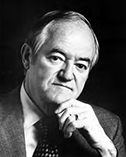 Vice President Hubert H. Humphrey
Vice President Hubert H. Humphrey
Senator Hubert Humphrey (pictured right) became Vice President when President Johnson was elected to a second term in office in 1964. Humphrey possessed a lively and extensive interest in science and made multi-hour visits to the Academy on a fairly regular basis in order to catch up on anything new, potentially exciting, or to raise questions about issues he had heard about by chance. It was a pleasure to be with him. He would have been a good friend of science had he been elected President in 1968. The State of Minnesota returned him to the Senate where he resumed many of his former activities.
The Enrico Fermi Laboratory
A crisis developed in the high-energy physics community in the mid 1960s. The Atomic Energy Commission had been using a committee of physicists under the chairmanship of Professor Norman Ramsey of Harvard University to make decisions concerning the type of high-energy accelerator that was most desirable to construct next. Seitz had served on the committee for a period and was familiar both with the individuals on it and with the issues under discussion. The most recent decision, supported by the AEC, had concluded that the next large accelerator should be constructed at the University of California at Berkeley, following a long succession of accelerators that had been created under the guidance of Ernest O. Lawrence, the inventor of the cyclotron. In the meantime, Lawrence had died, so new leadership was in charge.
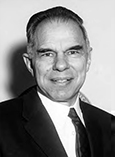 The high-energy community was much disappointed when the proposed plans for the new accelerator were finally disclosed, since the new machine exhibited little imaginative flexibility and would clearly be primarily of local interest. Seitz began to receive visits from colleagues on the Ramsey committee who felt strongly that the decision to build the next device at Berkeley should be reopened and revalued. The scientific member of the AEC at that time was Professor Glenn T. Seaborg (pictured left), a distinguished Berkeley chemist. On visiting Seaborg, Seitz found that the commissioner was well aware of the complaints and had decided independently that they could not be ignored, even though contemplation of a review must have provided him painful hours. The new leaders at Berkeley were old friends and colleagues. Seaborg had shared a Nobel Prize with one of them.
The high-energy community was much disappointed when the proposed plans for the new accelerator were finally disclosed, since the new machine exhibited little imaginative flexibility and would clearly be primarily of local interest. Seitz began to receive visits from colleagues on the Ramsey committee who felt strongly that the decision to build the next device at Berkeley should be reopened and revalued. The scientific member of the AEC at that time was Professor Glenn T. Seaborg (pictured left), a distinguished Berkeley chemist. On visiting Seaborg, Seitz found that the commissioner was well aware of the complaints and had decided independently that they could not be ignored, even though contemplation of a review must have provided him painful hours. The new leaders at Berkeley were old friends and colleagues. Seaborg had shared a Nobel Prize with one of them.
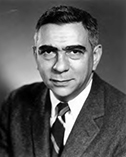 In any event, the Academy created a new organization, The University Research Association (URA), with a small guiding staff and offered to use it as a base to review the situation. Dr. Emanuel R. Piore (pictured right), a highly respected physicist who had played an important role in the evolution of the Office of Naval Research, was selected to chair the review committee, giving particular emphasis to the matter of the choice of site. Dr J. C. Warner, the president of what was then the Carnegie Institute of Technology, was selected to chair a committee that would determine the nature of the governing board of the organization for the accelerator. Early on, it had been agreed that the membership of the board would be national in scope and representative of the leadership in the high energy physics community from all parts of the country.
In any event, the Academy created a new organization, The University Research Association (URA), with a small guiding staff and offered to use it as a base to review the situation. Dr. Emanuel R. Piore (pictured right), a highly respected physicist who had played an important role in the evolution of the Office of Naval Research, was selected to chair the review committee, giving particular emphasis to the matter of the choice of site. Dr J. C. Warner, the president of what was then the Carnegie Institute of Technology, was selected to chair a committee that would determine the nature of the governing board of the organization for the accelerator. Early on, it had been agreed that the membership of the board would be national in scope and representative of the leadership in the high energy physics community from all parts of the country.
The Piore committee carried out a very thorough study of possible sites in cooperation with many experts. As that process reached its climax, Seitz received a call from President L. B. Johnson stating that when the list of acceptable sites had been reduced to the six best, he desired to make the final choice. He selected an acceptable site in Illinois, not far from Chicago and O'Hare Airport, which worked out very well.
At this point the Academy made URA an independent self-sustaining organization with the help of a member of its legal staff, Leonard Lee Bacon, who remained with URA. Its directors, in turn, selected Robert R. Wilson, then at Cornell University, as the director of the new laboratory.
Wilson and his colleagues provided excellent, highly imaginative leadership. The laboratory was eventually named after Enrico Fermi. It has had a very productive history. Unfortunately, later plans by URA to develop a larger successor accelerator in Texas did not receive continuing Congressional support. Leadership in the field of experimental high-energy physics will probably eventually go to the European laboratory centered in Geneva, Switzerland.
Aldabra Islands
A crisis of another kind arose as a result of a request for help from the Royal Society of London. Its leaders had learned that the Royal Air Force, using funding from United States, planned to establish an active airbase on the Aldabra Islands in the Indian Ocean in order to over-fly Africa for the purpose of gathering intelligence-oriented information. Up to that point the international scientific community had treated the relatively unpopulated islands informally as a very special nature reserve. As a result there was much concern about the inevitably significant ecological changes that would be produced by an airbase. The British government had rejected the objections advanced by the Royal Society, so its leaders turned to the U.S. National Academy for help. It would appear that for some reason or other the Royal Society had lost some of the influence it might have had on the government agencies at an earlier time. Seitz knew from his service on the Defense Science Board that the Pentagon was about to launch intelligence gathering satellites that would be much more effective. He discussed the matter with the Secretary of Defense, Robert McNamara, who turned the issue over to a young member of his staff, Rodney W. Nichols, with instructions to intervene in the funding of the British plan until the satellites were in operation. The islands were officially made a nature reserve in 1976.
Unidentified Flying Objects
Throughout human history some individuals have come to believe that they have experienced the supernatural or its equivalent. In our own time such experiences are often associated with the appearance of creatures from another planet either in our own or in another galaxy. They move about in machines of very advanced construction, popularly known as flying saucers, but technically designated as Unidentified Flying Objects, or UFOs. While many of the individuals who have had this experience or “sighting” are airplane pilots, they actually represent a small, although significant, component of the group that claims to have witnessed UFOs.
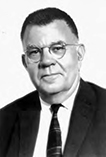 In 1965, the U.S. Air Force decided that it would try to get to the bottom of the matter by having a thorough study of the issue made by a distinguished group of scientists that would serve under the chairmanship of an individual who was widely respected within the scientific community. To be assured of retaining some degree of direct contact with the study, they would fund it through the institution, presumably a university, in which the chairman was located. Their representatives did, however, ask the Academy for advice in the selection of the chairman. While mulling the situation over with a number of colleagues, Seitz finally decided, with some reluctance, that the best person would be Professor Edward U. Condon (pictured right), then on the faculty of the University of Colorado at Boulder, who was a deeply admired friend and counselor of long standing.
In 1965, the U.S. Air Force decided that it would try to get to the bottom of the matter by having a thorough study of the issue made by a distinguished group of scientists that would serve under the chairmanship of an individual who was widely respected within the scientific community. To be assured of retaining some degree of direct contact with the study, they would fund it through the institution, presumably a university, in which the chairman was located. Their representatives did, however, ask the Academy for advice in the selection of the chairman. While mulling the situation over with a number of colleagues, Seitz finally decided, with some reluctance, that the best person would be Professor Edward U. Condon (pictured right), then on the faculty of the University of Colorado at Boulder, who was a deeply admired friend and counselor of long standing.
Early on, in his college days, Condon had been a colorful newspaper reporter before turning to physics as a profession. In the latter role he had earned world-class status. The reluctance to call on him stemmed from the fact that he had just passed through a very stormy decade during which he had been driven from the position as head of the National Bureau of Standards by a powerful group in Congress that resented his strong support of a movement favoring civilian rather than military control of the uses of nuclear energy, a movement that eventually led to the creation of the Atomic Energy Commission. He had finally found a refuge back in the relatively quiet academic world where he had begun and had every reason to avoid any activity that might lead to bitter controversy.
As it happened, Condon accepted the assignment with considerable enthusiasm, and helped in the selection of a superb group of scientists who formed the advisory study panel. The study extended over two years and led to a detailed report that contained reviews of individual cases as well as general analysis. The chairman summarized the latter in eloquent and perceptive language. In many cases, the members of the advisory committee were able to provide probably correct explanations for the observations in what might be called everyday down-to-earth terms. It was, however, emphasized that the ability to use the scientific method in reaching a solution to a problem requires the ability to repeat in detail the circumstances under which any observation is made, a condition that is difficult to meet when dealing with individual random chance sightings, as is the case for UFOs. In other words, anything resembling a precise explanation for the phenomena related to the sighting of UFOs lies outside the framework of exact science at present. Nevertheless, the chairman and his committee urged the funding agencies to continue to support research in the field.
One should add that the two-year study was anything but tranquil. A very militant subgroup of those who were convinced that UFOs were of extraterrestrial origin also believed the government knew all the answers but was hiding the facts for its own presumably deceitful purpose. They regarded the study as a diversion and made a point of attacking Condon quite viciously. Fortunately, he stood up to the abuse although there were trying times. On observing the fracas, one news reporter said to Condon: “Doctor, in looking over your history, I note that you have been at the center of lots of trouble!” Condon replied: “It isn't hard.”
Tricentennial of The French Academy Of Sciences
The French Academy of Sciences was founded in 1666, just after the Royal Society of London and the end of the religious wars. The French planned to have a significant celebration of the anniversary in 1966. Invitations were sent to science academies throughout the world welcoming representatives. Seitz accepted the invitation with appreciation of the fact that he would encounter one of the periods in which President Charles de Gaulle was venomously angry at the United States. Also it was likely that he would be the only U. S. citizen there who had actually been born and raised in United States, as turned out to be the case.
The opening ceremony was a highly colorful affair. President de Gaulle occupied an elevated throne-like chair, a military band played briskly in keeping with a prepared schedule, and the academicians entered the hall at the appointed moment wearing specially designed uniforms that were topped off by gallant cocked hats. Their marching pace did not conform even closely to the timing of the band. As a result, the band was replaced by a chamber orchestra on subsequent formal entrances of the academicians.
Seitz soon found that, with a few notable exceptions, even old friends conspicuously avoided him. As a result, he had much free time between meetings that were spread out over a week to visit museums, the palaces, and other old haunts in wonderful Paris. Thirty years later, he attended a medal-presenting meeting of the French Academy in conjunction with awards given to several young biochemists by a small American foundation. The mood and behavior of those involved in the gathering on that occasion was much different, resembling closely what one would have expected at a similar convivial meeting taking place at 2lst and Constitution Avenue.
New Structures
In the meantime, there had been a renewal of the question of the way in which the professional engineers and the medical profession should be represented in the structure of the Academy. Both groups played major advisory roles and yet were in proportion greatly under-represented within the membership. The solution for engineers proved to be relatively simple, although it inevitably required much discussion. A leading group of engineers had decided to create an independent Academy of Engineering, but when offered the possibility by the Council of the National Academy of Sciences to join the existing National Academy under the umbrella of the original charter of 1863, it accepted, all with the understanding that in addition to electing its own professional membership it would have appropriate representation on the Governing Board of the National Research Council and on the Committee on Science and Public Policy. In the discussions, there had been some concern regarding the actions Congress might have taken if it had had freedom of choice in the matter. The proposal that the two academies unite was probably first made by the ongoing executive officer, S. Douglas Cornell.
The ranking members of the medical profession did not have a built-in solution comparable to that of the engineers to offer. Fortunately, Dr. James Shannon had just retired from the National Institutes of Health and was prepared to serve as special advisor to the Academy on this matter. He favored an organization somewhat parallel to that of the engineers in which the elected membership would be composed of distinguished medical doctors in various categories, including those involved in clinical practice and in research. It would also be represented on the governing board of the National Research Council. Shannon apparently foresaw the problems the medical profession would face in the years ahead as a result of matters such as the increased socialization of medicine and ethical issues associated with applications of some advances in biochemistry. He felt it would be good to have a strong organization representing the medical profession in Washington.
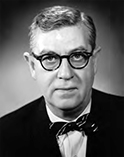 James A. Shannon
James A. Shannon
Shannon (1904–1994) (pictured left) had a dynamic career. He started medical research in the field of renal physiology, but shifted to the search for anti-malarial drugs during World War II. At war's end, he accepted a position as head of an industrial pharmaceutical laboratory for four years, gaining special experience that served him well in his later public services. In 1949, he joined the Institutes of Health (NIH), a relatively modest organization at the time, reporting to the Surgeon General in the Public Health Service. There he became a member of the National Heart Institute and was placed in charge of its research program in 1953 when NIH was absorbed into the newly created Department of Health Education and Welfare. His remarkable qualities of leadership soon became generally evident and he was selected to be the director of The National Institutes of Health when the position became open in 1955. With the skillfully won cooperation of some powerful members of the Senate and House, as well as the Executive Office, he started the transformation of the NIH into the relatively well-funded, essentially all-pervasive institution we know today. In setting very high standards of professional achievement for NIH, Shannon, somewhat like John Powell, made enemies of some individuals on the Hill who had more mundane goals of their own. As in Powell's case, they were able to force him from office somewhat prematurely once his more powerful supporters departed from the Hill.
Shannon left Washington for a position in New York in 1969 and turned the matter of developing the relationships between the medical community and the Academy over to an old medical friend, Dr. Walsh McDermott, who greatly desired to be involved in laying the foundations for the new addition to the Academy. McDermott, along with colleagues, developed a much more diverse and cosmopolitan structure for the new entity, now known as the Institute of Medicine (IOM), than that envisioned by Shannon. It was attached to the Academy. The acceptance of the McDermott plan by the Council occurred during the presidency of Professor Philip Handler (1969–1981). Shannon was not at all pleased with the result at the time and threatened not to accept the status of a charter member. For one reason or another he did not follow through on this threat and is listed among the founding members. The first president of the IOM was Professor John Hogness, who served between 1972 and 1974. McDermott (1909–1981) had a distinguished research career in the Cornell Medical School working on the development of antibiotics, some of which was carried out in cooperation with René Dubos of The Rockefeller Institute across the street. He had an essentially life-long struggle with tuberculosis and benefited from his own research.
Office of Technology Assessment
For many decades, both the scientific community and the members of Congress involved in scientific affairs had wondered if it would be possible to create a committee or board that might be able to forecast the effects that some newly introduced technical development could eventually have upon society. The concept is not unreasonable as is demonstrated by the fact that individuals such as Patrick E. Haggerty and Gordon E. Moore were able to make fairly good estimates of the ultimate consequences of the introduction of semiconductor-based electronics quite soon after the invention of the integrated circuit. Finally, two members of the House took the lead in the matter by preparing and introducing a bill that would create an Office of Technology Assessment (OTA) linked to the Hill. The two had different party affiliations, but they realized full well that good science is non-partisan. One of the individuals was Emilio Daddario (Democrat) and the other Charles Mosher (Republican). A companion bill was introduced in the Senate.
Their planning began early in the 1960s and continued throughout the decade. At the time, Representative Daddario was chairman of the House Subcommittee on Science Research and Development and had a remarkably clear concept of the place of science in the underpinnings of our society. The pair recognized among other things that the ultimate effects of the applications of science could have deleterious side effects as well as great benefits and hoped that the former could be minimized if revealed sufficiently early. Seitz spent much time with them discussing the details of their bill in the course of its creation.
At the core of the original plan was a Technical Assessment Board (TAB) consisting of six senators and six representatives, equally divided between both political parties in recognition of the fact that basic science should be apolitical. The chairmanship and vice chairmanship of the TAB would alternate between Senate and House in succeeding Congresses. The TAB would appoint a director of the OTA to serve for a six year term and would also appoint an Advisory Council (AC) of ten eminent citizens from industry, academia or elsewhere outside the federal government to advise the agency. In the original bill, four of these were to be appointed by the president of the United States. Advice could also be sought from outside the AC. The comptroller general of the United States and the Congressional Research Service served as statutory members. The OTA would take on assessments at the request of the chairman of any congressional committee. The chairman could request the work personally, on behalf of a ranking minority member or on behalf of a majority of the members of a committee. The Technology Assessment Board could request work, as could the director. The OTA would acquire a staff as determined by budgets and requests.
Compatible bills for House and Senate were ready by 1970, but were held over for voting in 1972. The House passed the bill essentially in the form developed by Daddario and Mosher, but the Senate insisted on significant changes at the request of Senator Jack Brooks from Texas, in consultation with colleagues in the Senate. His amendment required the number of members of the TAB from each house be reduced to five, three from the majority party and two from the minority. Also it required that the revised TAB select the director. These changes placed most of the authority for controlling the OTA in the hands of the two houses and in the hands of the majority party when it controlled both. One might have thought that the Republican leadership would have wanted to retain the Office when it regained control of the two houses, but apparently the party leadership felt otherwise in 1995.
In the meantime Daddario was no longer in the House of Representatives and did not play a formal role in the final decisions relating to the creation of the OTA. At the request of his party, he had run for the position of governor of his home state of Connecticut in 1970 and failed to win. He was appointed director of the Office of Technology Assessment in 1973, holding the post until 1977, and was president of the AAAS for a two-year term (1977–1978).
A New Auditorium
What remained to be accomplished in a major way in the improvement of facilities at 21st and Constitution Avenue was the addition of a suitable auditorium. For several decades after 1922 a small lecture room adjacent to the Board Room had served most needs for convocations of the academy members, including the gatherings at which new members were elected. This proved inadequate after World War II as the membership grew rapidly in size. The Great Hall soon began to provide a substitute. It, however, did not have good acoustical properties and required restaging for each important meeting in which it served as a lecture hall. There was adequate room for such an addition in the space between the East and West Wings that had been added by Bronk. Unfortunately, a sum between four and five million dollars was required to achieve the goal. A very special plan would be needed if the campaign seeking the funds was to be successful.
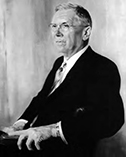 Hugh L. Dryden
Hugh L. Dryden
Dr. Hugh Dryden (1898–1965) (pictured right), a native of Maryland, was one of the leading aeronautical engineers in the country. He had completed his formal advanced education in his professional field at The Johns Hopkins University in 1922 and joined what was then the National Bureau of Standards as head of the aerodynamics section. He carried out advanced research in the sonic and turbulent ranges of airflow, helping to pave the way for what became supersonic flight. During World War II, he worked with the NDRC on the use of armed live bats as guided missile in defense against hostile Japanese aircraft, a program that was sufficiently successful to gain commendation. This was one of the several methods developed for such defense, the most successful being the proximity fuse developed by Merle Tuve with the cooperation of the Navy under the guidance of Captain William S. Parsons and based on the use of a miniature microwave radar unit imbedded in the weapon. It was usually fired from a gun. Parsons incidentally was later the officer in charge of the arming in flight of the nuclear bomb dropped on Hiroshima.
In 1947 Dryden became director of flight of the National Advisory Committee on Aeronautics (NACA), which had been created in World War I and was central for much of planning in the field of aviation in the country over the years. He was appointed director of the entire organization two years later.
When as mentioned earlier the Soviet Union launched the small earth-orbiting satellite Sputnik in the autumn of 1957, the U.S. government terminated NACA and, in 1958, passed the legislation needed for its replacement, the National Aeronautics and Space Administration (NASA). Dryden drafted the necessary documents, which were accepted in the form he presented with relatively little change. Soon after, he began encouraging studies of the nature of the heat shields that would be required on some rockets during re-entry into the atmosphere from very high orbit.
Although the White House and Congress recognized the sterling scientific, technical and organizational capabilities that Dryden possessed, they were not prepared to select him as administrator of NASA. His natural approaches to matters associated with public relations were reserved and non-partisan, being conditioned both by his basic personality, which was low-key, and many years as a reserved public servant. In consequence the position of administrator of the new agency was left in temporary hands, namely those of Dr. T. Keith Glennan, the president of what was now the Case Western Reserve University, for a year or so while awaiting a newly elected president of the United States. Dr. Glennan immediately offered the position of associate administrator to Dryden. In the meantime Dryden had also been offered several major non-governmental positions, such as a professorship at the Massachusetts Institute of Technology, but he had become so devoted to the promises NASA offered for new activities in space that he decided to remain in Washington.
Dryden had been elected Home Secretary of the Academy in 1955 and felt sufficiently honored by the post that he maintained it until his death ten years later. He revered the academy and his association with it so much that he was happy to carry on with the additional burden in spite of his heavy duties at NASA.
The new president of the United States, John F. Kennedy, decided that one of the primary missions of NASA should be to land astronauts on the moon, the challenge for a great adventure.
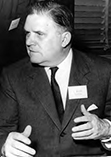 James E. Webb
James E. Webb
James E. Webb (1906–1992) (pictured left), mentioned earlier, was one of the most remarkable individuals of the many who seek a career in Washington. Mervin Kelly, the president of the Bell Telephone Laboratories, once commented that anyone who has been associated with Webb in a significant way would have their life changed irreversibly, a situation to which many can attest. It was also a statement that could be applied to Kelly. In keeping with his ambition for a political career, Webb studied law, passed the Washington bar examinations in 1936 and began to enter practice. It was interrupted by a period in the Marine Corps but at the end of the war, in 1946, he became undersecretary of the Treasury, which was followed by a period as head of the Bureau of the Budget.
Webb left Washington during the Eisenhower administration to take a sequence of private positions, mainly with industry, but returned in 1960 to seek a post in the Kennedy administration. By this time, his many special aptitudes were widely appreciated and President Kennedy offered him the now vacant position of administrator of NASA. He accepted under the condition that the program be regarded as the start of a continuing one, not focused only on a single successful voyage for short-term propaganda purposes. President Kennedy agreed.
As mentioned earlier, the Academy had formed an advisory board on space science under Lloyd Berkner soon after the appearance of Sputnik. It had an enthusiastic constituency that was greatly stimulated by discoveries such as x-ray emitting stars and the ionization belts around the earth (the Van Allen Belts), which were being made with instrumented space probes. The committee soon began to receive financial and other support from NASA. President Kennedy's decision to send astronauts to the moon, however, caused a split within the constituency since a substantial fraction of the group would have preferred to see NASA focus, at least initially, on unmanned missions that possess high scientific value, such as continuing the study of X-ray-producing stars. Another component of the committee was sympathetic to President Kennedy's proposal since it was prepared to recognize the values the plan possessed for international publicity and domestic politics, if successful. They also realized that success in a manned program could stimulate public interest in associated scientific research.
It so happened that the chairman of the Academy's space committee who followed Berkner strongly opposed the president's plan. Moreover, he was quite outspoken about expressing his opinions. Webb quickly learned of this and asked Seitz if the chairman of the committee, a brilliantly productive scientist, could be replaced. The response had to be: “Jim, the membership would replace me first!”
Webb had the gift of judging the merits of individuals in other professions rapidly and fully appreciated the talents of Dryden, whom he asked to continue on as deputy administrator. The two were perfect complements in their posts, and much of the success of the Apollo program can be ascribed to their close partnership. It lasted until the end of 1965 when Dryden finally succumbed to a slowly developing cancer for which he had been receiving steady treatment while continuing to work industriously. In the meantime, the pattern of operation necessary for the success of the Apollo program had been well established. Since Webb had become very close to Dryden and missed his presence keenly on both the personal and technical sides, he felt that some special steps should be taken to honor his former colleague.
As a result of several conversations between Webb and Seitz, a decision was made to raise a fund in Dryden's name to construct the auditorium. Once the basic idea had taken hold, the council of the Academy appointed a small guiding committee composed of individuals who had known and admired Dryden both as a personal friend and highly experienced engineer and administrator. The initial group consisted of Donald W. Douglas, Jr. (chairman), Allen V. Astin, Detlev W. Bronk, Leonard Carmichael, James H. Doolittle, Harry F. Guggenheim, S. Paul Johnston, Augustus B. Kinzel, Vice Admiral Emory S. Land, U.S.N. (ret.), Grover Loening, Merle A. Tuve, and James E. Webb.
John S. Coleman, the executive officer of the Academy at the time, became as deeply involved in the program as any other participant and was to no small degree responsible for the success achieved. Additional names were added to the advisory committee as the raising of funds progressed and new opportunities arose.
It was hoped that a substantial amount of the needed money could be derived from the aerospace industry, which had benefited so much from Dryden's lifetime involvement in the field as well as his work for NASA. Industry ended up providing about twenty percent of the funds needed. The greatest fraction came from the private foundations, about one third. The membership of the Academy was also very generous within its means. Webb contributed all of the lecture fees he received from the many public addresses that he gave concerning the development of the Apollo program.
As the final goal of the fund drive began to be reached, the choice of new sources began to shrink and the Academy began to draw on some of its relatively small reserve funds. Fortunately, the National Institutes of Health (NIH) came to the rescue at a critical moment, just as the hazard of serious inflation began to loom on the horizon, along with an associated increase in construction costs. It appeared that one might be pursuing the end of a rainbow. Seitz visited Dr. James Shannon and discussed the shortfall. Shannon asked if it would be possible to designate a special area in the structure that would be created for use in the extensive medical advisory work of the Academy. A discussion with the architect demonstrated that this was quite feasible without radical changes in plans, whereupon Shannon gathered together his staff, popularly known as “the Irish Mafia,” and with its help in the review of budgets was able to contribute seven hundred and fifty thousand dollars, which made it possible to sign a contract for construction.
Once the critical sum of money needed to provide a useful auditorium had been reached, Dr. William O. Baker, a member of the academy, president of the Bell Telephone Laboratories and personal advisor to Mr. Paul Mellon on special philanthropic matters, advised the latter to add five hundred thousand dollars to the fund “to ensure that the architectural style of the addition matches the high level of the existing structures in the complex.”
The selection of an architect placed Seitz in an awkward position. The logical choice was Wallace Harrison, who had played such a significant role as a young man in the design of the original building under the guidance of Clarence Goodhue and later in the design of the East and West Wings. Bronk had also employed Harrison in the upgrading of the campus of The Rockefeller University once he became president there. However, Bronk, a man occasionally short of temper, had a serious dispute with the architect over the not entirely surprising failure of a novel form of ceramic tile roofing on the University's newly-constructed auditorium. A long-standing productive friendship was seriously disrupted. Bronk felt that Harrison might well prove to lack interest in planning the auditorium. Yet Seitz decided that it would be improper to ignore Harrison and arranged a meeting to discuss the issue. Harrison virtually jumped at the opportunity, partly for sentimental reasons and partly to renew close associations with his architectural friends and colleagues in Washington who would review his plans for approval.
The program of design moved rapidly and the groundbreaking ceremony for the auditorium took place on August 1, 1968. The construction began immediately after and was completed at the end of 1970. The dedication took place at the annual meeting in the following April, during the presidency of Philip Handler.
James Webb expressed disappointment that Hugh Dryden's name was not more prominently displayed in connection with the auditorium. In reviewing the matter, the council of the Academy feared at the time that if segments of the Academy building began to receive special names associated with donors, the edifice might soon become cluttered with name plaques and lose much of the distinctiveness associated with its primary devotion to science. As a result, the Academy adopted a rule, valid for the period, that no nameplates would be added to the building. There was to be only one exception, namely the West Wing, which had an understandable origin. Dryden, above all, would have understood.
In the meantime, the council of the Academy has had second thoughts about the matter of increasing its private endowment by various means, including affixing the names of appropriate prominent donors to portions of the headquarters complex on Constitution Avenue. Under the proper circumstances, this could provide added freedom from politically motivated influence originating from the government and alleviate, at least in part, Joseph Henry's great concern about the ultimate effectiveness of the institution as a result of its close ties to government.
Continue reading next chapter: Philip Handler

